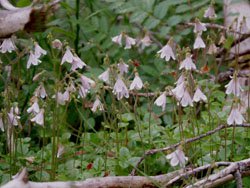Study finds twinflower in Scotland exhibits genetic effects of chronic population fragmentation
 Habitat fragmentation is widely thought to contribute to the decline of plant species. In part, this is due to the restriction it places on the flow of genes (which occurs through pollen and seed dispersal) within a plant population, creating sub-populations within which localised inbreeding and loss of genetic variation occurs. This can lead to a reduction in the ability of populations to adapt to changing environmental conditions and can contribute to local extinction of those sub-populations isolated by fragmentation.
Habitat fragmentation is widely thought to contribute to the decline of plant species. In part, this is due to the restriction it places on the flow of genes (which occurs through pollen and seed dispersal) within a plant population, creating sub-populations within which localised inbreeding and loss of genetic variation occurs. This can lead to a reduction in the ability of populations to adapt to changing environmental conditions and can contribute to local extinction of those sub-populations isolated by fragmentation.
The effects of habitat fragmentation vary from species to species but are likely to be greatest in self-incompatible plant species with restricted seed and pollen flow. Linnaea borealis, commonly known as twinflower, is a classic example of one such species. In Scotland it occurs as patches located predominantly within the remnants of the native Caledonian Scots pine (Pinus sylvestris) woodlands. This once extensive habitat suitable for twinflower has been reduced to less than one percent of its former area and the remaining habitat is now highly fragmented.
This study aimed to: 1) use a combination of landscape scale mapping of populations and population genetic analysis to determine the effect that chronic habitat fragmentation has had on twinflower in its core habitat in the Cairngorms National Park in Scotland, and 2) use this information to provide management guidelines for alleviating the effects of past fragmentation on remaining twinflower patches.
Overall the study concludes that twinflower in Scotland seems to be experiencing extreme genetic effects of chronic population fragmentation. Almost 80% of the 123 identified patches of the species contained a single clone and 91% of patches were further than the maximum pollinating distance from their nearest neighbours. It also found significant relatedness of clones within the first 1.5 km. With only 16% of patches having the capacity for seed production, it concludes that the vast majority of the current population of twinflower is sustained through vegetative reproduction alone as they are genetically isolated from other clones so that they have no immediate prospects for future seed production.
It proposes that the only way to restore sexual reproduction and evolutionary potential to existing patches of twinflower is artificially to transplant compatible clones from elsewhere within the pollination range. Without information about patterns of local adaptation of twinflower, it explains that matching of the environments of donor and transplant sites will be the best way to maximise the chance of transplants being adapted to their new site. It goes on to recommend that transplant genotypes should be sourced from patches greater than 1.5 km away, but occupying as far as possible similar environmental conditions. Such a programme of artificial transplantation of twinflower to restore seed set within patches, making use of these guidelines, is already underway in the Cairngorms National Park.
The full version of this paper can be assessed here.
This research was conducted by a partnership of scientists including Dr Stuart A’Hara and Dr Joan Cottrell of Forest Research.
